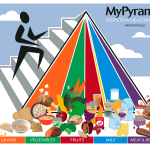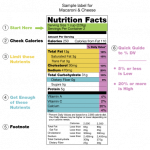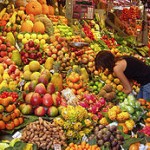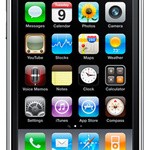Foods today have a number additives, artificial ingredients, and chemicals with long and confusing names. With all the processing that goes on, and with all the health problems that can come with eating foods that could be unfamiliar, it is little surprise that, in the midst of a growing obesity epidemic and growing food-related health concerns, that many are becoming interested in having a better idea of what is in their food. You don’t have to be a nutritionist, nurse or other health care professional to know what’s in your food, though. Here are 33 sites that can help you figure out what’s in any food you eat:
Nutrition Information
 How healthy is that food anyway? What kinds of nutrients are in it? You can learn about nutrition data, and what is in your food when you visit these web sites, which are devoted to helping you learn about nutrition data, and what’s in your food.
How healthy is that food anyway? What kinds of nutrients are in it? You can learn about nutrition data, and what is in your food when you visit these web sites, which are devoted to helping you learn about nutrition data, and what’s in your food.
- NutritionData: This is perhaps the best sight out there for nutrition information. Offers helpful insight into what’s in your food, and how you can choose foods that are healthier to eat.
- Nutrition.gov: The U.S. government offers information on learning about proper nutrition, learning what goes into food, and understanding how you can plan nutritional meals for your family.
- Food and Nutrition Information Center: Another government web site, this provides facts about food nutrition, and provides dietary guidance as well as information on food composition and life cycle nutrition.
- Nutri-Facts: Get an inside look at what’s in your food, using this searchable site with information on more than 6,000 different foods.
- Nutrient Data Laboratory: The USDA provides yet another helpful tool in understanding what sort of nutritional value your food has. This keyword-based search tool can help you learn about what’s in your food.
- Nutrition: Learn about proper nutrition, how to find out what is in your food, and how to follow a diet rich in healthy things for your body.
- Nutrition Facts, Nutrition News, Food Nutrition Data, Diet News, Naturopathy Digest: Get information and new on what’s happening in the world of nutrition, as well as what is in your food. A naturopathy twist to nutrition is included, as well as recipes.
Reading Food Labels
 One of the most useful skills you can have is reading nutrition labels. Here are some sights that can help you learn to read food labels so that you understand the nutritional value of your food.
One of the most useful skills you can have is reading nutrition labels. Here are some sights that can help you learn to read food labels so that you understand the nutritional value of your food.
- Wikipedia: Provides a great overview of food labels, and how to read them. Also goes over some of the differences between food labels in Australia and New Zealand, Canada, the EU, Mexico and the U.S.
- FDA: The U.S. Food and Drug Administration provides a helpful guide to reading nutrition fact labels.
- KidsHealth: There is a helpful guide on understanding food labels, and properly reading them, on this web site.
- American Heart Association: A step-by-step guide to reading food labels, and deciphering what the phrases on the labels really mean.
- Pediatrics: Offers a helpful guide to reading food labels, and understanding what different sections mean.
- Life Clinic: Learn the lingo used on food labels, and get an overview of how to more effectively read labels so that you can make better nutrition decisions.
- MedlinePlus: Learn how to properly read and use nutrition labels to help you make better food choices.
Counting Calories
 It helps to know how many calories your food has. It can also be helpful to understand that where your calories come from does matter. Here are some great sites to help you learn more about calories, and getting more of the right ones.
It helps to know how many calories your food has. It can also be helpful to understand that where your calories come from does matter. Here are some great sites to help you learn more about calories, and getting more of the right ones.
- Calorie Count: This service from About.com offers you calorie counts for thousands of foods, and provides you with insight as to where those calories are coming from.
- The Calorie Counter: Get basic calorie intake information, and track what you are eating with help from this searchable site.
- CalorieKing: Get calories information on different foods, searchable and divided into easy to understand categories.
- CalorieLab: Interesting information on calories in food, as well as data on how many calories you burn doing different activites.
- Weight Loss: This site includes helpful information on how to properly calculate your caloric needs each day, as well as how to choose foods that help you keep a healthy balance.
- Wellsphere: Get some solid information on different calorie questions related to fruits, vegetables and liquids.
- HowStuffWorks: An excellent guide to calories, how they work, and where they com from.
- Cleveland Clinic: Learn about calories, and the differences between fat and calories. Also, understand how to read calorie claims on food labels.
Eating Vegetarian and Organic
 Many people are interested in eating vegetarian, or vegan. Additionally, there are those who are interested in eating organic and natural foods, even if meat is involved. Here are some sites that can help you learn about choosing these types of foods.
Many people are interested in eating vegetarian, or vegan. Additionally, there are those who are interested in eating organic and natural foods, even if meat is involved. Here are some sites that can help you learn about choosing these types of foods.
- Epigee: Understand the labeling system related to organic foods, and how to read the claims.
- MarketWatch: “Playing the organic foods game” is a great crash course in reading organic food labels from a site we might not normally consider a “food” site.
- Naturally Savvy: Offers a helpful look at understanding what “organic” and “natural” labels mean on meat products.
- Explore Veg: Provides a helpful guide to reading food labels if you are a vegetarian.
- Almost Vegetarian: Get an inside look at reading food labels to understand whether animal based products are in your food — even if you wouldn’t normally think of the food as “meat.”
- Suite 101: Offers a helpful guide on beginning vegan food shopping, and how you can spot which foods contain animal products.
- Vegan Soapbox: A look at what sorts of foods are labeled “vegan”, and how you can tell if they are really vegan.
iPhone Food Applications
 If you are interested in taking nutrition information with you wherever you go, these iPhone apps can help you get the nutrition information that you need.
If you are interested in taking nutrition information with you wherever you go, these iPhone apps can help you get the nutrition information that you need.
- Lose It!: Offers calorie counts for a number of foods, including break downs of whether they come from fat, protein or carbs. You can also input new information from nutrition labels.
- Slim Down Shopping List: Helps you find your best options while at the grocery store, based on nutrition information and your goals.
- Calorie Tracker: Large database of foods, and you can search more than 525,000 foods for nutrition information.
- Mint Nutrition: Keep track of food, and put together “plates” based on what you like and what is healthy.
